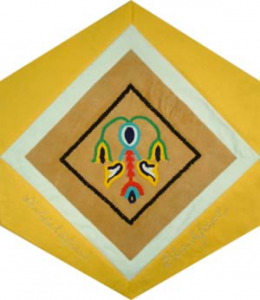Blackfoot (Nitsitapii)

The Block
The symmetrical floral design on the Blackfoot block was traditionally used to decorate side-seam moccasins for special occasions. The beadwork was done with glass seed beads on deer-hide by Diane (Msewebek) Nadon Mackenzie. Originally such decoration was made with naturally dyed porcupine quills; a skill once considered so sacred that women underwent an initiation ceremony before learning the art. With the arrival of white traders in the 1840s, using glass seed beads became a popular alternative to porcupine quills, thereby spawing more intricate designs.
Cultural Profile
The Blackfoot First Nation, proudly call themselves Nitsitapii, meaning “The Real People.” The Blackfoot are actually a confederacy of the Siksika/Blackfoot, Peigan/Pikuni, Kainai/Blood and North Peigan/Pikuni tribes. Their native language is Nitsipussin, or the “Real Language.” They migrated to the plains of Canada’s western provinces from the Great Lakes region, often relocating to take advantage of buffalo migrations. At one time, their territory extended from Edmonton, Alberta to the Yellowstone River, south into North Dakota and as far west as the Rocky Mountains. They shared religious, ceremonial and social practices, creating strong connections between the tribes, and together formed a cohesive unit, the Blackfoot Confederacy. Their military strength earned them the title “the Lords of the Great Plains.”
The buffalo was sacred to the Blackfoot, providing much of what they needed for survival, and they had several techniques for hunting these magnificent creatures. The 7,000 year-old Head-Smashed-In site, located on a hill, provides evidence that the Nitsitapii drove herds of buffalo over cliffs in order to kill many at once. The Blackfoot, who were known as expert hunters and fierce warriors, were introduced to the horse in 1730. They easily integrated the animal into their plains culture and became excellent horseback riders.
Buffalo and deer hides were scraped, cleaned, smoked and tanned, and then used to make clothing and tepee coverings. Women learned this extensive and exhaustive process at a very young age and each was judged on the quantity and quality of her workmanship. The fact that women made the tepees gave them ownership. Young girls were also trained by their elders in the art of decorating clothing with beads and other more traditional paraphernalia.
The decimation of buffalo herds by the 20th Century resulted in starvation for many Blackfoot and the loss of a major part of their culture. Despite drastic lifestyle changes and the Canadian-U.S. border cutting across their traditional territory, the Blackfoot have survived. They maintain strong connections to their heritage and nurture a vibrant and dynamic cultural life within their communities.
Sponsor: Barrington & Ronaye Cooper and Rick & Linda Lussier and family, in memoriam Florence Lussier Tremblay, their mother
